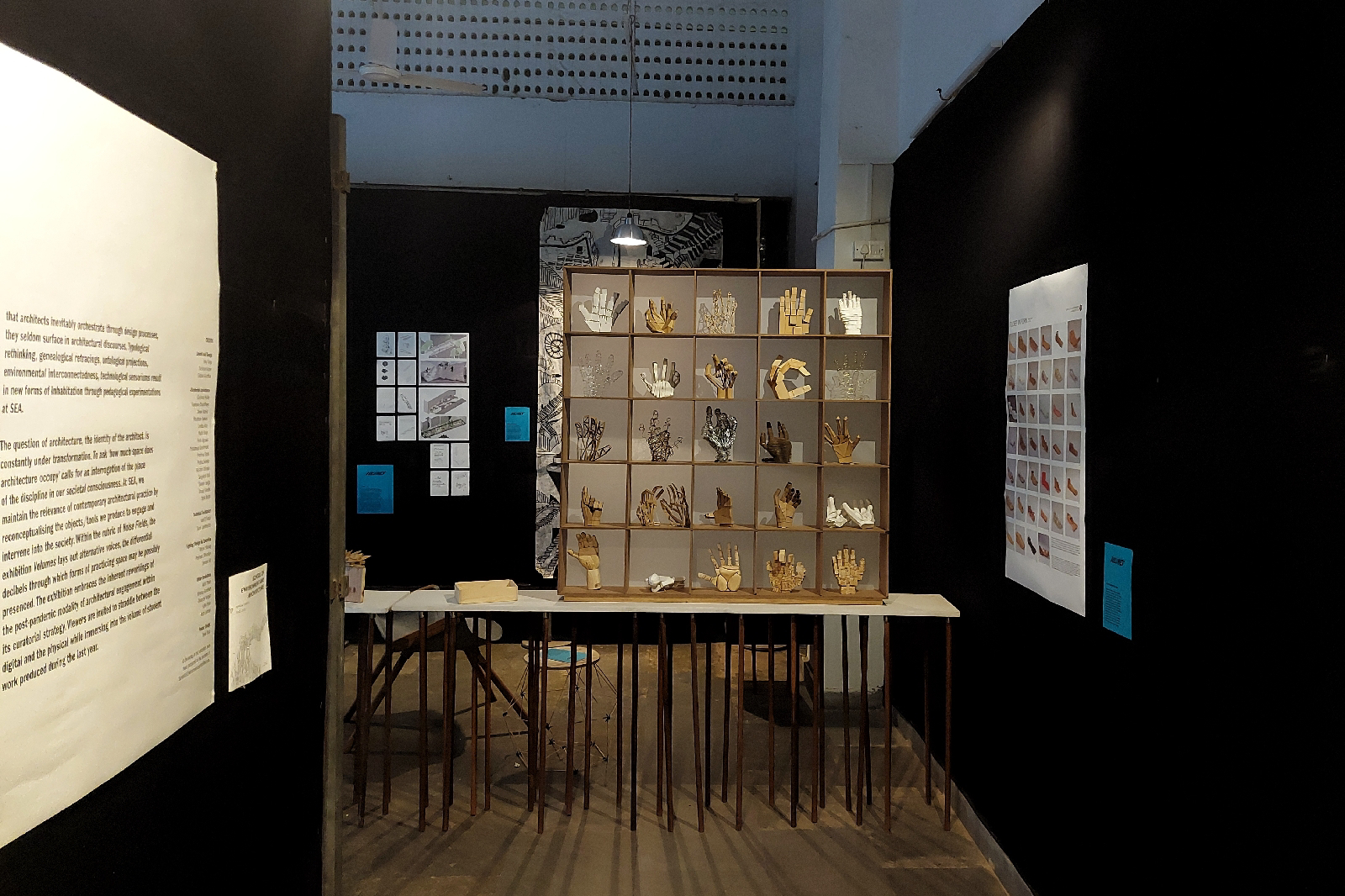Annual Exhibition 2022-23
Volumes
February 8-11 2023
1000-1900 hrs IST
How much space does architecture occupy?
To be sure, the question of “how much,” “space” and “architecture” are hinged around the conception of “volumes” - which one may consider as the fundamental act of composing architecture. The exhibition Volumes interrogates these three dimensions of quantities, enclosures and practice, at once, in different measures by indexing the key ideas that emerged in the pedagogic experiments at the School of Environment & Architecture (SEA) during 2021-22.
“How much” opens the question of measure through the drawing of phenomena and experience. ‘Volume’ as a vibrating sonic entity suggests the surpassing of the cartographic length, breadth and height towards the mapping of densities, intensities, closeness, sparseness as much as temporal expansions and contractions. These are some of the first impressions through which we begin to appreciate and assimilate space – those that otherwise remain folded into the pleats of memory. “How much” is a call to consider relativity, relook at standards, and formulate new methods of representing architecture through perceived phenomenon.
Moving beyond the ‘container’ logic of space has been one of the key concerns of spatial pedagogy at SEA. Speaking of ‘volume’ rather than a ‘building’ allows us to dwell upon programmatic mixings, power hierarchies, pressure and temperatures, forces and flows that lend the rhythms, frequencies, remixes and beats of everyday life within our built environment. While these are values that architects inevitably orchestrate through design processes, they seldom surface in architectural discourses. Typological rethinking, genealogical retracings, ontological projections, environmental interconnectedness, technological sensoriums result in new forms of inhabitation through pedagogical experimentations at SEA.
The question of architecture, the identity of the architect, is constantly under transformation. To ask ‘how much space does architecture occupy’ harks us to interrogate the place of discipline in our societal consciousness. At SEA, we maintain the relevance of contemporary architectural practice by reconceptualising the objects/tools we produce to engage and intervene into the society. Within the rubric of Noise Fields, the exhibition Volumes lays out alternative voices, the differential decibels through which forms of practicing space may be possibly presenced. The exhibition embraces the inherent reworkings of the post-pandemic modality of architectural engagement within its curatorial strategy. Viewers are invited to straddle between the digital and the physical while they indulge within the volume of student work produced during the last year.
February 8-11 2023
1000-1900 hrs IST
How much space does architecture occupy?
To be sure, the question of “how much,” “space” and “architecture” are hinged around the conception of “volumes” - which one may consider as the fundamental act of composing architecture. The exhibition Volumes interrogates these three dimensions of quantities, enclosures and practice, at once, in different measures by indexing the key ideas that emerged in the pedagogic experiments at the School of Environment & Architecture (SEA) during 2021-22.
“How much” opens the question of measure through the drawing of phenomena and experience. ‘Volume’ as a vibrating sonic entity suggests the surpassing of the cartographic length, breadth and height towards the mapping of densities, intensities, closeness, sparseness as much as temporal expansions and contractions. These are some of the first impressions through which we begin to appreciate and assimilate space – those that otherwise remain folded into the pleats of memory. “How much” is a call to consider relativity, relook at standards, and formulate new methods of representing architecture through perceived phenomenon.
Moving beyond the ‘container’ logic of space has been one of the key concerns of spatial pedagogy at SEA. Speaking of ‘volume’ rather than a ‘building’ allows us to dwell upon programmatic mixings, power hierarchies, pressure and temperatures, forces and flows that lend the rhythms, frequencies, remixes and beats of everyday life within our built environment. While these are values that architects inevitably orchestrate through design processes, they seldom surface in architectural discourses. Typological rethinking, genealogical retracings, ontological projections, environmental interconnectedness, technological sensoriums result in new forms of inhabitation through pedagogical experimentations at SEA.
The question of architecture, the identity of the architect, is constantly under transformation. To ask ‘how much space does architecture occupy’ harks us to interrogate the place of discipline in our societal consciousness. At SEA, we maintain the relevance of contemporary architectural practice by reconceptualising the objects/tools we produce to engage and intervene into the society. Within the rubric of Noise Fields, the exhibition Volumes lays out alternative voices, the differential decibels through which forms of practicing space may be possibly presenced. The exhibition embraces the inherent reworkings of the post-pandemic modality of architectural engagement within its curatorial strategy. Viewers are invited to straddle between the digital and the physical while they indulge within the volume of student work produced during the last year.


